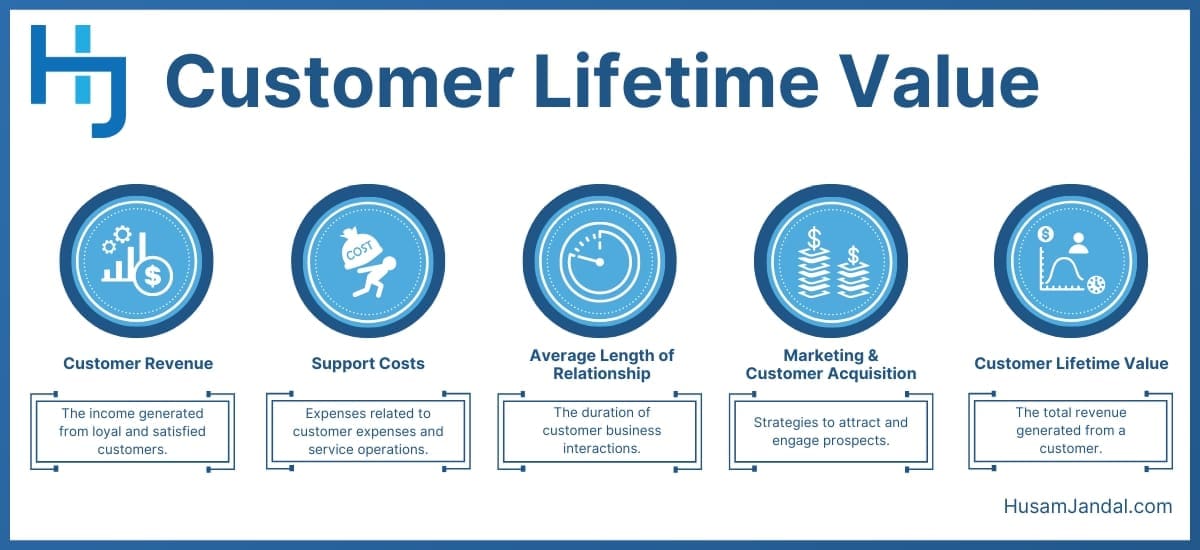
A few terms you’ll frequently hear are “Customer Lifetime Value” (CLV) and “Cost Per Acquisition” (CPA). Many marketers, including myself, often talk about these marketing metrics in terms of how to measure your success.
However, if you’re running an agile marketing team, these metrics aren’t only beneficial for measuring results or even making predictions—they can help you pave the way for success too. Give me five minutes and I’ll show you how to transform your CPA by working with your CLV, just as I do for my clients when I start a new project.
Cost Per Acquisition = How Much is Spent to Gain One Customer
The cost to acquire or convert a customer is one of the most important metrics that marketers track. CPA (Cost Per Acquisition) and CAC (Customer Acquisition Cost) are sometimes used interchangeably to measure the cost of acquiring a customer. It can become a bit of a focal point if you’re always trying to whittle it down, but it’s generally easy to calculate if you have the right tracking methods in place.
To calculate CPA, you’ll need to know:
- Spend: The total amount of money spent on marketing efforts, typically per channel.
- Conversions: The number of people who become customers.
CPA Calculation
(Spend) / (Conversions) = CPA
CPA Calculation Example
To put this into action, let’s say you’re spending $25,000 per month on pay-per-click ads and, each month, two people purchase your product. Your formula will be:
($25,000) / (2) = $12,500; your CPA is $12,500
What is Customer Lifetime Value (CLV)
The second metric to track is Customer Lifetime Value (CLV), sometimes referred to by the abbreviation LTV. This is the total amount you’ll earn from a customer. CLV provides insight into how much money you should be spending on customer acquisition by determining how much money a customer relationship could bring to your business in the long run. Determining this value is a bit more complex because there are several calculation methods with dozens of formulas spread between them. For the sake of simplicity, this will focus on the three you’re most likely to encounter or use: historic, predictive, and traditional.
How to Calculate Historic CLV
As the name implies, historic CLV looks at the sum of a customer’s past purchases.
To calculate historic CLV, you’ll need to know:
- Purchases: The total amount a customer spent with your company over a period of time.
- Average Gross Margin (AGM): The portion of each sale that represents profit, expressed as a percentage.
Historic Customer Lifetime Value Formula
(Purchase 1 + Purchase 2 + Purchase 3…) x AGM = Historic CLV
Historic CLV Calculation Example
Let’s say your customer purchased from you four times and spent $100 each time. You’ve also calculated your AGM and 25 percent of all purchases is profit. Your formula will be:
(100 + 100 + 100 + 100) x 0.25 = 100, your historic CLV is $100.
Predictive CLV
As you may have noticed, historic CLV really only works when customer behavior remains the same. That might be true if you run a business with cycles. For example, maybe you sell yearly calendars, and your customer base only purchases once a year, or you run weekend workshops, and customers attend six times. Most businesses aren’t that easy to assess because customer behavior changes. This is where predictive CLV comes in.
To calculate predictive CLV, you’ll need to know:
- Average Transactions (T): The average number of transactions your business has per month.
- Average Order Value (AOV): The average revenue your business brings in from each order.
- Average Gross Margin (AGM): The portion of each sale that represents profit, expressed as a percentage.
- Average Lifespan (ALT): The average length of time a customer is active with your business, represented in months. Think of it as the span from the moment the customer makes their first purchase up until they churn.
- Total Clients: The number of active clients your business had during the month you’re measuring.
Predictive CLV Formula
(T x AOV x AGM x ALT) / Total Clients = Predictive CLV
Predictive CLV Calculation Example
Let’s say you’re looking at the month of January, and you had 20 transactions, an AOV of $100, an AGM of 25 percent, an ATL of 24 months, and had 5 active clients. Your formula will be:
(20 x 100 x 0.25 x 24) / 5 = $2,400, your predictive CLV is $2,400.
Traditional CLV
Most businesses use the traditional method of calculating CLV.
To calculate traditional CLV, you’ll need:
- Your gross margin per customer lifespan (GML): The total amount of profit you expect to receive from a customer the entire time they’re with you.
- Your Retention Rate per Month (R): The percentage of customers who made a purchase over the course of a month compared to the month before. It will always be the inverse of your churn rate. For example, if 100 customers made a purchase last month, but this month only 99 did, your churn rate is 1 percent, and your retention rate is 99 percent.
- Discount Rate (D): Generally set at 10 percent, the discount rate is used to account for inflation.
Traditional CLV Formula
GML (R / 1 + D – R) = traditional CLV
Traditional CLV Calculation Example
To work through this, let’s say your GML is $2,000, and you retain 75 percent of your customers. Your formula is:
2000 (0.75 / 1 + 0.10 – 0.75) = $800, your traditional CLV is $800.
Simple CLV Alternate
Clearly, calculating CLV can be complex, and there are benefits as well as drawbacks to each method. The other issue worth noting is that these methods usually rely on raw sales or the transactional value of a customer. They completely overlook one of the greatest revenue-driving factors of a happy customer—referrals! With that in mind, there’s one more calculation you should familiarize yourself with.
To calculate this simple CLV alternate, you’ll need:
- Tenure: Average customer tenure in cycles in months or years.
- Volume: Average customer purchase volume per cycle.
- Referrals: Average number of new referred customers from each existing customer.
Simple CLV Alternate Formula
(Tenure) x (Volume) = A
(Referrals) x (A) = B
A + B = CLV
Simple CLV Calculation Example
To put this into action, let’s say your average customer stays with your company for 48 months and spends $500 each month during his or her time with you, but also refers two new customers as well. Your formula will be:
A. (48 months) x ($500) = $24,000
B. (2) x ($24,000) = $48,000
($24,000) + ($48,000) = $72,000; your CLV is $72,000
You’re Probably Using CLV and CPA Wrong
Yes, these formulas are used by marketers everywhere, but they’re still not the full picture. If you’re only using CLV and CPA to measure your results, and, like most marketers, you’re setting your budgets based on historic spend, you aren’t using agile tactics or being strategic. Worse yet, you may get trapped in the mindset of how to reduce spending rather than how to get greater ROI from your marketing investments.
Set Your Maximum Investment Based on Your CLV

If you’re focused on strategic and agile marketing techniques, you should be using your CLV to determine your CPA investments when you’re establishing campaigns.
To calculate your maximum investment, you’ll need to know:
- CLV: Customer lifetime value, as calculated above
- Ceiling: The percent of a customer’s lifetime value you can comfortably spend on each customer acquisition
CLV & CPA Formula
(CLV) x (Ceiling) = Maximum Investment
CLV & CPA Calculation Example
Let’s say your organization has a high-profit margin. You can comfortably say you’re able to spend 20% of your CLV to acquire each customer and you have the $72,000 CLV from the first example.
($72,000) x (20%) = $14,400; your maximum investment is $14,400
Using Your CLV to Calculate a CPA Amplifies Your Marketing Results
Again, under commonly used marketing models, you’re essentially spending what you’ve always spent where you’ve always spent it. It doesn’t allow you to allocate more resources to channels that are performing better or capitalize on what’s really working for you.
By flipping the way you look at CPA and using your CLV to determine a maximum investment, you become more agile and dynamic with your marketing approach. You can rapidly allocate your investments to what’s really working for your business here and now.
You’ll find the CLV data reveals information about customer behavior too. For example, you may discover that customers referred by other customers spend more or refer more or that your customers spend less the longer they stay with you. When you identify these trends, you can capitalize on the opportunities and take corrective action on any issues.
Develop a Powerhouse Digital Marketing Strategy
Not every company can set the CPA ceiling at 20 percent. If your organization has a lower profit margin, you may need to reduce yours to 15 percent, 10 percent, or something else entirely. If you’re not sure what your ceiling is or you want to have an agile digital marketing strategy that generates real ROI from your investments for the long term, I can help.
As an experienced business and digital marketing consultant that has transformed Fortune 100 companies and SMEs across the globe, I welcome the opportunity to ensure your organization meets its goals too. Contact me for a consultation.





































































